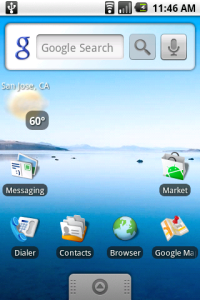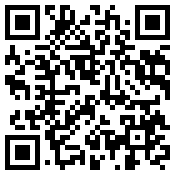I’m a little late on this review, but I thought I’d post me thoughts anyway.
At the macro feature level, it’s a toss up. There are minor aspects that are missing from one or the other, or just different, but at a high level it’s 90% feature overlap. This would be a boring blog entry if I left it at that though. Let me point out a few notable differences …
Form Factor / Size
Android is of course just the operating system, but I thought I’d quickly compare the iPhone against the two released Android hardware platforms: the HTC Dream and the HTC Magic. The iPhone feels as if it’s higher quality. Both HTCs feel like typical not-built-to-last cell phones. I can’t speak for the actual longevity of any of the devices, this is just my feeling.
The iPhone makes maximum use of it’s size; the screen encompasses almost the entire front of the unit. The Dream has a smaller screen that doesn’t expand to the edges of the unit like the iPhone. The Dream and Magic’s screens occasionally feel too small, which is something I never experienced with the iPhone. Indeed, the HTC models sport a 3.2″ vs. the iPhone’s 3.5″.
The iPhone feels almost as if it’s the optimal length and width. Anything less would make the screen feel too small. Any less thickness would make me feel like the unit wasn’t structurally sound. The HTC Dream feels thicker and bulkier than it should. This is at least partly due to it’s slide out hard keyboard. The Magic comes closer to the iPhone but still falls short.
If the HTC hardware really turns you off, just hang in there. While the choices are limited now, the near future will see an explosion of devices running Android.
Background Applications
This was sounding quite one-sided, up until now.
The iPhone has limited ability to run applications in the background. For example, you are running Pandora. Now you switch to check an email. Pandora stops playing. Another good example is a GPS run tracker application that records speed and routes. It works fine as long as it’s in the foreground, but if you switch out to play some music, it stops recording.
Actually, a certain, limited set of iPhone app are allowed to run in the background. These include but are not limited to: music player. AIM, and mail (the new mail checker part anyway). However, in general, 3rd party apps are not allowed to partake.
Conversely, Android is quite advanced in this regard. Any app will run in the background. It’s just part of how the operating system runs and requires nothing special from the application itself. Whether it’s a GPS tracking application, streaming music, or whatever, they just continue to work as you go about and perform other tasks on the phone.
From a developer’s perspective I can understand the limitation on the iPhone. As soon as you allow apps to execute in parallel, you have to consider memory limitations, battery consumption, access to shared resources, etc. All in all a much harder problem.
I think, many of iPhone users won’t notice or care about this limitation. They get new email notifications, and their music plays in the background. That being said, there are complaints from the iPhone community about this limitation. Time will tell if Apple responds.
Applications
Both the iPhone and Android have an extensive set of robust quality applications available through their respective store fronts. In general, the iPhone has more, and better applications available, but the average user will be able to find what they need in either place.
Keyboards
The iPhone’s on screen keyboard works better. Part of this has to do with the larger screen size with the iPhone vs. the HTC hardware. Larger screen size means bigger buttons and less fat fingering. The HTC dream has a fold out hard keyboard. It’s hard keyboard for heavy duty / soft keyboard for quick and dirty typing is an excellent combo. The Dream wins overall. The HTC Magic of course has no hard keyboard. Android’s soft keyboard is usable, but inferior.
The downside of a hard keyboard is that it’s mechanical, and like any mechanical device is prone to failure based on the amount of use. No specifics here, just my opinion.
Touch Screen Ergonomics
The iPhone’s touch screen is ultra responsive with no noticeable delay. Excellent overall. Android’s is not as good. There’s a slight but apparent delay between touching and when the OS reacts. Also, it is sometimes difficult to click onto things at the screen edge. Touch screen gestures in Android feel clunky. For example, a “flick” is at best jerky and sometimes doesn’t animate at all, just jumping directly to the end point. It feels as is the HTC hardware is under powered.
Widgets

Android Home Screen with Weather Widget
In Android, a widget is a mini app that can run on your home screen. The closest analog is an OSX widget. On the iPhone, it would be as if the application icons could change and display information dynamically without the app being started. Of course the iPhone has no concept of a widget. Some of the app icons do update, but this is reserved for system apps like mail.
This is a very handy feature. From my home Android home screen, I can see the current weather, new messages, clock of my choosing, etc. without having to run the respective applications.
Notifications
In Android, the notification bar is always at the top of the screen. It shows small icons indicating the presence of certain types of notifications, and the bar and be pulled down to show them in detail, and allow direct access to the source of the notification with a click. The iPhone has no official notification mechanism. Some things like mail, IM, and messaging generate an audio notification, or even a popup modal dialog, but few apps make use of this. Moreover, the problem with the modal dialog is that it interrupts whatever you are doing and forces you to take action immediately.
Screen Orientation
There are a few things that really annoy me with regard to how the iPhone handles screen orientation. The first is that it sometimes gets stuck. This seems to happen when the orientation changes while the phone is locked. I notice is a lot with the music player. When I unlock, it’s in the wrong orientation until I flip it back the other way, then back to where I want it.
Second is that it’s not available on all apps. Some apps handle the change, others do nothing, and there’s no way to tell except memorizing how each app will react. In Android, all apps react to the change. Well, more precisely, the OS reacts by modifying the screen resolution and orientation. This is really all I want – adjust screen real estate in the X or Y direction. My reverse engineering of how this works is that on the iPhone, the app receives an event and is given the option of reacting to it. If the app doesn’t re-draw itself according to the new orientation, nothing happens. In Android, the OS revises the X and Y size of the screen, and re-paints the app. As long as the app has laid itself out with proper gravities and fills it will do the right thing.
My third point is how the stock iPhone apps react. Some apps like mail, compose do what you’d expect … give more space for the soft keyboard and more horizontal space to enter the message. Other apps like the music player arbitrarily change their behavior. The portrait mode for music player is the typical music player controls, well done. Landscape mode is the proverbial horizontal album art stack view, which is nice eye candy but really pointless for every day use.
The Cloud
Android is tightly coupled to your Google data. That’s an understatement. It won’t work without a Google login. If you have taken Google’s red pill, this is a very good thing. One login gets you your contacts, mail, calendar, photos, videos, and on and on. And better yet, all this data is in Google’s cloud. There’s no need to manage the data locally: keep it backed up, synchronize, etc. If you haven’t taken the red pill, things are not so rosy. Integration into other systems like Exchange, Lotus, etc are spotty at best. I have no direct experience with this so my comment is just based on comments I’ve seen floating in the ether.
iPhone on the other hand by default synchronizes to your local system via iTunes. There is MobileMe, which is Apple’s cloud offering, but it’s a pay service ($99 / year) and it has data transfer / size limits. The iPhone can work with the major Google services, but it’s tedious process of configuring each one.
Music Player
As a music player, both the iPhone and Android perform. The iPhone is excellent: the iPod you know and love that was once a dedicated device is now encapsulated as one of many applications on the iPhone. Android’s stock music player is basic but satisfactory.
It’s a shock to not be tied to the iTunes hegemony, but I prefer it. On Android, you just mount your SD card and drag your music onto it.
The main problem is the HTC’s lack of a 3.5mm audio port. At first I didn’t think this would be an issue. Purchase a $5 USB to be 3.5mm adapter. However, the first problem was that the only adapter I could find locally was 3′ long. Combined with my headphones I ended up with 7′ of cabling hanging off my belt and getting caught on everything. I since ordered a shorter adapter online.
Consider the battery life of smart phones, my typical day is to sit down at my desk and listen while charging. What I didn’t consider is that the HTC’s multi-purpose charge and headphone port doesn’t allow this. There are adapters that split the HTC’s port into audio and charge, but they are reported not to work with the latest Android release (!). I don’t have a solution to this yet.
Summary
Overall, the iPhone wins. Android and it’s hardware platforms are definitely rough around the edges and pale in comparison to the iPhone’s polished hardware and software. I feel Android has the potential though, in that it’s doing a lot of things correctly from the start.



 Posted by Jeffrey Blattman
Posted by Jeffrey Blattman 


